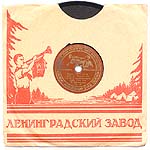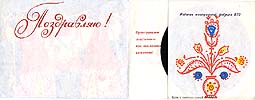1900-1940
Boom of 78 rpm
Local Industry
Long Playing
Special Issues
"Sounding Letters"
Envelopes
Listen Records
Guestbook
Radio Museum
SHELLAC DISK |
| Introduction 1900-1940 Boom of 78 rpm Local Industry Long Playing Special Issues "Sounding Letters" Envelopes Listen Records Guestbook Radio Museum |
|
 |
This plate from 1950s of Leningrad Works (78 rpm, diam. 150 mm, label 55 mm) with pioneer songs bears only a special number of toy-disks nomenclature that makes its exact dating difficult. |
 |
It is surprising that there was practically no information on such plates (except the title of the song and the factory logo, the pressing on the disk reveals nothing more). |
 |